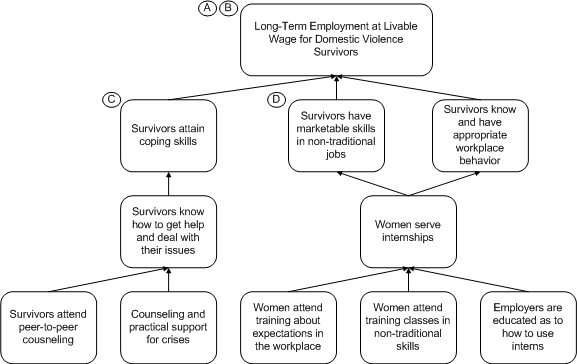Backwards Mapping and Connecting Outcomes
After the first step of laying out the long-term goals and a simple change framework, comes a more detailed stage of the mapping process. Building upon the initial framework, we continue to map backwards until we have a framework that tells the story we think is appropriate for the purposes of planning. Sometimes, this will require much more detail because stakeholders want to identify the “root” causes of the problem they hope to resolve. In other cases, the map will illustrate three or four levels of change, which display a reasonable set of early and intermediate steps toward the long term goal.
Because this work is challenging and most social change programs or broader initiatives have a lot of moving parts, change frameworks usually go through many revisions. Outcomes are added, moved and deleted until a map eventually emerges that tells a story the group can agree on. For the users, the debate is often the most valuable component of TOC because they are now jointly defining the expectations, assumptions and features of the change process. TOC participants are required to make explicit, and agree upon, the underlying logic of the initiative improving which improves the productivity and accountability.
Commentary
For the Project Superwomen example, program designers asked themselves what women would need if they were going to have long-term employment. Specifically, how would the project’s participants achieve the three identified preconditions (coping skills, marketable skills, and appropriate workplace behavior) to the ultimate outcome? That required identifying what it would take for women to achieve coping skills, job skills and knowledge of workplace behavior.
Drawing Connections
We continue illustrating how the long-term outcomes are linked to the intermediate ones. In stage 1, we connected the final long-term outcome of employment at a livable wage to the three intermediate outcomes with solid, arrowed lines, indicating that they are preconditions. This process holds for the intermediate outcomes as well. For “Survivors know how to get help and deal with their issues” we use arrowed lines to show that the two outcomes below it are direct preconditions of it.
Illustrating connections helps to spot-check the initiative’s logic as well as identifying where the initiative should intervene. Following the logical path from outcome to proposed precondition often points out inconsistencies. TOC participants are able to readjust their frameworks and drop or add outcomes as necessary. They also understand when these outcomes will take place on their own or require an intervention by the initiative to make it happen, such as a program activity.

